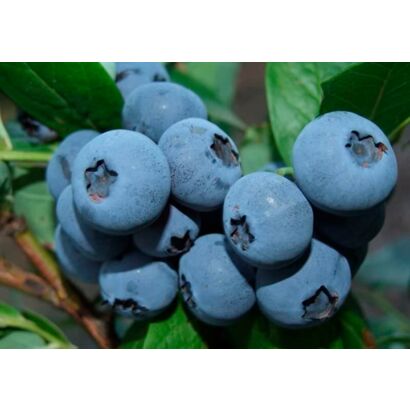Blueberry Bonus
Ripening period: July-August
Fruits: 1.8-2.3 gr., blue
Growing conditions: outdoors
Yield: high, up to 8 kg/plant
Breeding: USA, Michigan
| Shipping and pickup: | |
| Ripening period | Medium late variety |
| fruit size | Large-fruited varieties |
| Productivity: | high |
| Selection | USA |
Blueberry Bonus was bred in 1978 by breeders from the University of Michigan. The progenitor of the variety was a wild shrub growing in North America, Vaccinium tall.
Variety advantages:
- large fruit size;
- high yield;
- decorative;
- frost resistance up to –35⁰С;
- withstands long-term transportation without loss of marketability.
Variety Features
Plant. Tall bush, 1.2–1.6 m., with spreading crown — up to 1.3 m wide. Shoots are brown, powerful, 2-3 centimeters in volume. Over time, the old branches fall off, giving way to young shoots.
The leaves are oval, with a smooth plate and short stems. Inflorescences are located at the ends of the branches, each produces 7-10 white flowers. Flowering blueberry bushes have decorative qualities, becoming a natural decoration for the site.
Fruits round, slightly flattened, large. Individual berries reach 3 cm in diameter, up to 2-2.5 gr. in weight. Ripe blueberry peel – dense, blue with a bluish bloom. Pulp – greenish, juicy, sweet.
It takes about two weeks from the moment of coloring the berries to full ripening. Therefore, before picking, tear off and try the berry. Unripe blueberries taste unsweetened and are removed without a characteristic click.
Variety Assignment – generic. Blueberries are suitable for fresh consumption, cooking, canning for the winter, freezing, selling in markets and supermarkets.
Yields and ripening terms. Blueberry yields Bonus begins to yield steadily, in the 3rd year after planting seedlings. Up to 8 kg of berries are harvested from one bush per season. Berries are ripening – at the end of July – August, not at the same time.
Immunity. The plant may be susceptible to gray and fruit rot, berry mummification, mosaic, drying and filamentous branches, red leaf spot. In order to prevent diseases, blueberries are treated with special preparations.
Growing conditions
The main requirement when growing blueberries «Bonus» refers to the soil, its composition and acidity. The soil for blueberries should be moderately acidic pH 3.5-4.8 and contain peat. For those regions where such soils cannot be found in nature, there are ready-made peat substrates for blueberries.
"Bonus" belongs to the northern frost-resistant varieties. Blueberries are able to overwinter in open ground under a thick layer of snow. But in the northern regions, and in areas with little snowy winters, it is more reliable to cover the bushes for the winter with an agro wave, and mulch the soil in the near-stem zone.
Variety "Bonus" capable of self-pollination, however, to obtain a full-fledged harvest, it is best to plant other blueberry varieties in the neighborhood that bloom at the same time.
Selection of seedlings
Before you buy Bonus blueberry seedlings, pay attention to the quality of the planting material.
- The age of suitable seedlings is 2-3 years,
- The root system – developed, moist, without breaks. Preferably closed type (with a clod of earth).
- Shoots "live" without dryness, damage and signs of disease.
Beware of fakes and contaminated planting material, buy Bonus blueberry seedlings in professional nurseries and specialized stores.
